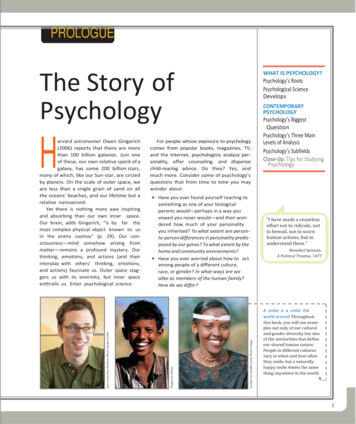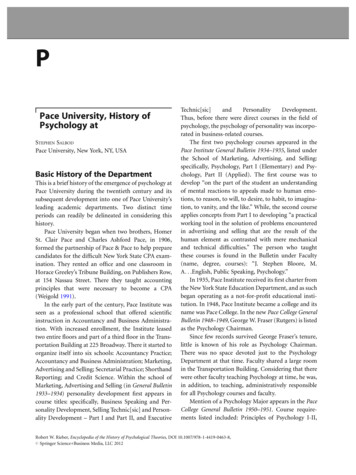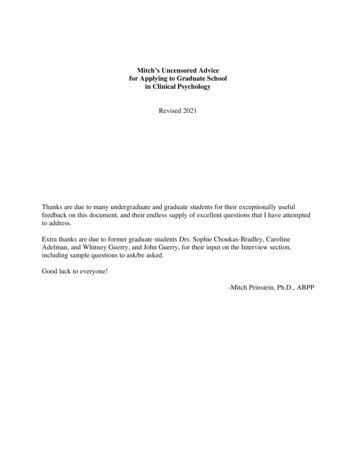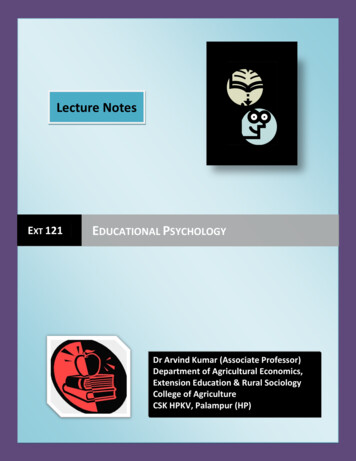
Transcription
HANDBOOKofPSYCHOLOGYVOLUME 7EDUCATIONAL PSYCHOLOGYWilliam M. ReynoldsGloria E. MillerVolume EditorsIrving B. WeinerEditor-in-ChiefJohn Wiley & Sons, Inc.
HANDBOOKofPSYCHOLOGY
HANDBOOKofPSYCHOLOGYVOLUME 7EDUCATIONAL PSYCHOLOGYWilliam M. ReynoldsGloria E. MillerVolume EditorsIrving B. WeinerEditor-in-ChiefJohn Wiley & Sons, Inc.
➇This book is printed on acid-free paper.Copyright 2003 by John Wiley & Sons, Inc., Hoboken, New Jersey. All rights reserved.Published simultaneously in Canada.No part of this publication may be reproduced, stored in a retrieval system, or transmitted in any form or by any means, electronic,mechanical, photocopying, recording, scanning, or otherwise, except as permitted under Section 107 or 108 of the 1976 UnitedStates Copyright Act, without either the prior written permission of the Publisher, or authorization through payment of theappropriate per-copy fee to the Copyright Clearance Center, Inc., 222 Rosewood Drive, Danvers, MA 01923, (978) 750-8400,fax (978) 750-4470, or on the web at www.copyright.com. Requests to the Publisher for permission should be addressed to thePermissions Department, John Wiley & Sons, Inc., 111 River Street, Hoboken, NJ 07030, (201) 748-6011, fax (201) 748-6008,e-mail: permcoordinator@wiley.com.Limit of Liability/Disclaimer of Warranty: While the publisher and author have used their best efforts in preparing this book, theymake no representations or warranties with respect to the accuracy or completeness of the contents of this book and specificallydisclaim any implied warranties of merchantability or fitness for a particular purpose. No warranty may be created or extended bysales representatives or written sales materials. The advice and strategies contained herein may not be suitable for your situation.You should consult with a professional where appropriate. Neither the publisher nor author shall be liable for any loss of profit orany other commercial damages, including but not limited to special, incidental, consequential, or other damages.This publication is designed to provide accurate and authoritative information in regard to the subject matter covered. It is soldwith the understanding that the publisher is not engaged in rendering professional services. If legal, accounting, medical,psychological or any other expert assistance is required, the services of a competent professional person should be sought.Designations used by companies to distinguish their products are often claimed as trademarks. In all instances where John Wiley &Sons, Inc. is aware of a claim, the product names appear in initial capital or all capital letters. Readers, however, should contact theappropriate companies for more complete information regarding trademarks and registration.For general information on our other products and services please contact our Customer Care Department within the U.S. at(800) 762-2974, outside the United States at (317) 572-3993 or fax (317) 572-4002.Wiley also publishes its books in a variety of electronic formats. Some content that appears in print may not be available inelectronic books.Library of Congress Cataloging-in-Publication Data:Handbook of psychology / Irving B. Weiner, editor-in-chief.p. cm.Includes bibliographical references and indexes.Contents: v. 1. History of psychology / edited by Donald K. Freedheim — v. 2. Researchmethods in psychology / edited by John A. Schinka, Wayne F. Velicer — v. 3. Biologicalpsychology / edited by Michela Gallagher, Randy J. Nelson — v. 4. Experimentalpsychology / edited by Alice F. Healy, Robert W. Proctor — v. 5. Personality and socialpsychology / edited by Theodore Millon, Melvin J. Lerner — v. 6. Developmentalpsychology / edited by Richard M. Lerner, M. Ann Easterbrooks, Jayanthi Mistry — v. 7.Educational psychology / edited by William M. Reynolds, Gloria E. Miller — v. 8.Clinical psychology / edited by George Stricker, Thomas A. Widiger — v. 9. Health psychology /edited by Arthur M. Nezu, Christine Maguth Nezu, Pamela A. Geller — v. 10. Assessmentpsychology / edited by John R. Graham, Jack A. Naglieri — v. 11. Forensic psychology /edited by Alan M. Goldstein — v. 12. Industrial and organizational psychology / editedby Walter C. Borman, Daniel R. Ilgen, Richard J. Klimoski.ISBN 0-471-17669-9 (set) — ISBN 0-471-38320-1 (cloth : alk. paper : v. 1)— ISBN 0-471-38513-1 (cloth : alk. paper : v. 2) — ISBN 0-471-38403-8 (cloth : alk. paper : v. 3)— ISBN 0-471-39262-6 (cloth : alk. paper : v. 4) — ISBN 0-471-38404-6 (cloth : alk. paper : v. 5)— ISBN 0-471-38405-4 (cloth : alk. paper : v. 6) — ISBN 0-471-38406-2 (cloth : alk. paper : v. 7)— ISBN 0-471-39263-4 (cloth : alk. paper : v. 8) — ISBN 0-471-38514-X (cloth : alk. paper : v. 9)— ISBN 0-471-38407-0 (cloth : alk. paper : v. 10) — ISBN 0-471-38321-X (cloth : alk. paper : v. 11)— ISBN 0-471-38408-9 (cloth : alk. paper : v. 12)1. Psychology. I. Weiner, Irving B.BF121.H1955 2003150—dc212002066380Printed in the United States of America.10987654321
Editorial BoardVolume 1History of PsychologyVolume 5Personality and Social PsychologyVolume 9Health PsychologyDonald K. Freedheim, PhDCase Western Reserve UniversityCleveland, OhioTheodore Millon, PhDInstitute for Advanced Studies inPersonology and PsychopathologyCoral Gables, FloridaArthur M. Nezu, PhDChristine Maguth Nezu, PhDPamela A. Geller, PhDVolume 2Research Methods in PsychologyMelvin J. Lerner, PhDFlorida Atlantic UniversityBoca Raton, FloridaJohn A. Schinka, PhDUniversity of South FloridaTampa, FloridaVolume 6Developmental PsychologyWayne F. Velicer, PhDUniversity of Rhode IslandKingston, Rhode IslandRichard M. Lerner, PhDM. Ann Easterbrooks, PhDJayanthi Mistry, PhDTufts UniversityMedford, MassachusettsVolume 3Biological PsychologyMichela Gallagher, PhDJohns Hopkins UniversityBaltimore, MarylandRandy J. Nelson, PhDOhio State UniversityColumbus, OhioVolume 7Educational PsychologyWilliam M. Reynolds, PhDHumboldt State UniversityArcata, CaliforniaDrexel UniversityPhiladelphia, PennsylvaniaVolume 10Assessment PsychologyJohn R. Graham, PhDKent State UniversityKent, OhioJack A. Naglieri, PhDGeorge Mason UniversityFairfax, VirginiaVolume 11Forensic PsychologyAlan M. Goldstein, PhDJohn Jay College of CriminalJustice–CUNYNew York, New YorkGloria E. Miller, PhDUniversity of DenverDenver, ColoradoVolume 12Industrial and OrganizationalPsychologyVolume 4Experimental PsychologyVolume 8Clinical PsychologyWalter C. Borman, PhDUniversity of South FloridaTampa, FloridaAlice F. Healy, PhDUniversity of ColoradoBoulder, ColoradoGeorge Stricker, PhDAdelphi UniversityGarden City, New YorkDaniel R. Ilgen, PhDMichigan State UniversityEast Lansing, MichiganRobert W. Proctor, PhDPurdue UniversityWest Lafayette, IndianaThomas A. Widiger, PhDUniversity of KentuckyLexington, KentuckyRichard J. Klimoski, PhDGeorge Mason UniversityFairfax, Virginiav
To our parents,Hugh and Martha ReynoldsandJoseph and Victoria Millerand to ourformer and current Teachers, Students, and Colleagueswho have continued to fuel and inspireour desire for life-long learning.William M. Reynolds, PhDDepartment of PsychologyHumboldt State University&Gloria E. Miller, PhDCollege of EducationUniversity of Denver
Handbook of Psychology PrefacePsychology at the beginning of the twenty-first century hasbecome a highly diverse field of scientific study and appliedtechnology. Psychologists commonly regard their disciplineas the science of behavior, and the American PsychologicalAssociation has formally designated 2000 to 2010 as the“Decade of Behavior.” The pursuits of behavioral scientistsrange from the natural sciences to the social sciences and embrace a wide variety of objects of investigation. Some psychologists have more in common with biologists than withmost other psychologists, and some have more in commonwith sociologists than with most of their psychological colleagues. Some psychologists are interested primarily in the behavior of animals, some in the behavior of people, and othersin the behavior of organizations. These and other dimensionsof difference among psychological scientists are matched byequal if not greater heterogeneity among psychological practitioners, who currently apply a vast array of methods in manydifferent settings to achieve highly varied purposes.Psychology has been rich in comprehensive encyclopedias and in handbooks devoted to specific topics in the field.However, there has not previously been any single handbookdesigned to cover the broad scope of psychological scienceand practice. The present 12-volume Handbook of Psychology was conceived to occupy this place in the literature.Leading national and international scholars and practitionershave collaborated to produce 297 authoritative and detailedchapters covering all fundamental facets of the discipline,and the Handbook has been organized to capture the breadthand diversity of psychology and to encompass interests andconcerns shared by psychologists in all branches of the field.Two unifying threads run through the science of behavior.The first is a common history rooted in conceptual and empirical approaches to understanding the nature of behavior.The specific histories of all specialty areas in psychologytrace their origins to the formulations of the classical philosophers and the methodology of the early experimentalists, andappreciation for the historical evolution of psychology in allof its variations transcends individual identities as being onekind of psychologist or another. Accordingly, Volume 1 inthe Handbook is devoted to the history of psychology asit emerged in many areas of scientific study and appliedtechnology.A second unifying thread in psychology is a commitmentto the development and utilization of research methodssuitable for collecting and analyzing behavioral data. Withattention both to specific procedures and their applicationin particular settings, Volume 2 addresses research methodsin psychology.Volumes 3 through 7 of the Handbook present the substantive content of psychological knowledge in five broadareas of study: biological psychology (Volume 3), experimental psychology (Volume 4), personality and social psychology (Volume 5), developmental psychology (Volume 6),and educational psychology (Volume 7). Volumes 8 through12 address the application of psychological knowledge infive broad areas of professional practice: clinical psychology(Volume 8), health psychology (Volume 9), assessment psychology (Volume 10), forensic psychology (Volume 11), andindustrial and organizational psychology (Volume 12). Eachof these volumes reviews what is currently known in theseareas of study and application and identifies pertinent sourcesof information in the literature. Each discusses unresolved issues and unanswered questions and proposes future directions in conceptualization, research, and practice. Each of thevolumes also reflects the investment of scientific psychologists in practical applications of their findings and the attention of applied psychologists to the scientific basis of theirmethods.The Handbook of Psychology was prepared for the purposeof educating and informing readers about the present state ofpsychological knowledge and about anticipated advances inbehavioral science research and practice. With this purpose inmind, the individual Handbook volumes address the needsand interests of three groups. First, for graduate students in behavioral science, the volumes provide advanced instruction inthe basic concepts and methods that define the fields theycover, together with a review of current knowledge, core literature, and likely future developments. Second, in addition toserving as graduate textbooks, the volumes offer professionalpsychologists an opportunity to read and contemplate theviews of distinguished colleagues concerning the centralthrusts of research and leading edges of practice in their respective fields. Third, for psychologists seeking to becomeconversant with fields outside their own specialty and forvii
Handbook of Psychology PrefacePsychology at the beginning of the twenty-first century hasbecome a highly diverse field of scientific study and appliedtechnology. Psychologists commonly regard their disciplineas the science of behavior, and the American PsychologicalAssociation has formally designated 2000 to 2010 as the“Decade of Behavior.” The pursuits of behavioral scientistsrange from the natural sciences to the social sciences and embrace a wide variety of objects of investigation. Some psychologists have more in common with biologists than withmost other psychologists, and some have more in commonwith sociologists than with most of their psychological colleagues. Some psychologists are interested primarily in the behavior of animals, some in the behavior of people, and othersin the behavior of organizations. These and other dimensionsof difference among psychological scientists are matched byequal if not greater heterogeneity among psychological practitioners, who currently apply a vast array of methods in manydifferent settings to achieve highly varied purposes.Psychology has been rich in comprehensive encyclopedias and in handbooks devoted to specific topics in the field.However, there has not previously been any single handbookdesigned to cover the broad scope of psychological scienceand practice. The present 12-volume Handbook of Psychology was conceived to occupy this place in the literature.Leading national and international scholars and practitionershave collaborated to produce 297 authoritative and detailedchapters covering all fundamental facets of the discipline,and the Handbook has been organized to capture the breadthand diversity of psychology and to encompass interests andconcerns shared by psychologists in all branches of the field.Two unifying threads run through the science of behavior.The first is a common history rooted in conceptual and empirical approaches to understanding the nature of behavior.The specific histories of all specialty areas in psychologytrace their origins to the formulations of the classical philosophers and the methodology of the early experimentalists, andappreciation for the historical evolution of psychology in allof its variations transcends individual identities as being onekind of psychologist or another. Accordingly, Volume 1 inthe Handbook is devoted to the history of psychology asit emerged in many areas of scientific study and appliedtechnology.A second unifying thread in psychology is a commitmentto the development and utilization of research methodssuitable for collecting and analyzing behavioral data. Withattention both to specific procedures and their applicationin particular settings, Volume 2 addresses research methodsin psychology.Volumes 3 through 7 of the Handbook present the substantive content of psychological knowledge in five broadareas of study: biological psychology (Volume 3), experimental psychology (Volume 4), personality and social psychology (Volume 5), developmental psychology (Volume 6),and educational psychology (Volume 7). Volumes 8 through12 address the application of psychological knowledge infive broad areas of professional practice: clinical psychology(Volume 8), health psychology (Volume 9), assessment psychology (Volume 10), forensic psychology (Volume 11), andindustrial and organizational psychology (Volume 12). Eachof these volumes reviews what is currently known in theseareas of study and application and identifies pertinent sourcesof information in the literature. Each discusses unresolved issues and unanswered questions and proposes future directions in conceptualization, research, and practice. Each of thevolumes also reflects the investment of scientific psychologists in practical applications of their findings and the attention of applied psychologists to the scientific basis of theirmethods.The Handbook of Psychology was prepared for the purposeof educating and informing readers about the present state ofpsychological knowledge and about anticipated advances inbehavioral science research and practice. With this purpose inmind, the individual Handbook volumes address the needsand interests of three groups. First, for graduate students in behavioral science, the volumes provide advanced instruction inthe basic concepts and methods that define the fields theycover, together with a review of current knowledge, core literature, and likely future developments. Second, in addition toserving as graduate textbooks, the volumes offer professionalpsychologists an opportunity to read and contemplate theviews of distinguished colleagues concerning the centralthrusts of research and leading edges of practice in their respective fields. Third, for psychologists seeking to becomeconversant with fields outside their own specialty and forvii
viii Handbook of Psychology Prefacepersons outside of psychology seeking information about psychological matters, the Handbook volumes serve as a reference source for expanding their knowledge and directing themto additional sources in the literature.The preparation of this Handbook was made possible bythe diligence and scholarly sophistication of the 25 volumeeditors and co-editors who constituted the Editorial Board.As Editor-in-Chief, I want to thank each of them for the pleasure of their collaboration in this project. I compliment themfor having recruited an outstanding cast of contributors totheir volumes and then working closely with these authors toachieve chapters that will stand each in their own right asvaluable contributions to the literature. I would like finally toexpress my appreciation to the editorial staff of John Wileyand Sons for the opportunity to share in the development ofthis project and its pursuit to fruition, most particularly toJennifer Simon, Senior Editor, and her two assistants, MaryPorterfield and Isabel Pratt. Without Jennifer’s vision of theHandbook and her keen judgment and unflagging support inproducing it, the occasion to write this preface would nothave arrived.IRVING B. WEINERTampa, Florida
Volume Prefaceeducational psychology has impacted and will continue toimpact reforms in teacher preparation, educational research,and policy. The five major sections of this volume coversignificant cognitive contributions to learning, development,and instruction; what we know about sociocultural, instructional, and relational processes critical to successful learning;the design of effective curriculum applications; and modelsof teacher preparation and educational research that will influence educational reform in the future.The chapters in this volume include many of the core domains of research that have fostered and are currently fostering major advances in the knowledge base and the basic andapplied endeavors in the field of educational psychology.Several conscious editorial decisions were made to shape thescope of this volume in order to minimize overlap with othervolumes in this Handbook. First, although prior handbooks inthe field of educational psychology have provided one ormore chapters on the historical precedents that have shapedthe field, such a chapter was omitted here because muchof this content was included in Volume 1 of the Handbook,History of Psychology. Similarly, although educational research and assessment chapters are typically included morecomprehensively within handbooks representing the field ofeducational psychology, only one chapter was included herebecause these topics are extensively covered in two otherHandbook volumes: Volume 2, Research Methods in Psychology, and Volume 10, Assessment Psychology, respectively. Finally, developmental issues, especially as they relateto issues of individual learning, interpersonal relationships,and schooling are embedded within and across many of thechapters included in this volume. This helped to lessenthe overlap with coverage of normal development topicsthat are the focus of Volume 6, Developmental Psychology.Limited coverage was given also to areas associated withchild and adolescent psychological disorders and mentalhealth and to wellness and prevention issues pertinent to creating safe and healthy school and community environments.These topics are covered in Volume 8, Clinical Psychology,and Volume 9, Health Psychology, respectively.The field of educational psychology has a rich heritage.As the chapters in this book attest, the field had shown anear exponential growth in the examination of complexSCOPE AND SIGNIFICANCE OF THIS VOLUMEThis volume of the Handbook of Psychology is dedicated tothe field of educational psychology. Educational psychologyis focused largely on the application of psychological principles to the study of human learning and development ineducational settings. Educational psychology traces its rootsto the beginnings of psychology as a field of study in theUnited States with the pioneering work of William James.Research in the field of educational psychology has progressed over the past century with an explosion of researchacross numerous domains of this field in the last quarter ofthe twentieth century.A careful reading of this volume will show that researchersin educational psychology are actively engaged in studyingthe complexity of learning and learner characteristics acrossmultiple systems and sociocultural settings. We suggest thatmore than any other area of psychology, the field of educational psychology has had a major impact in helping to prepare children for living in an increasingly diverse, globalworld of rapid change. Educational psychologists over the lasttwo decades have contributed to a burgeoning literature on individual and internal cognitive processes related to learning.Along with our greater knowledge of cognitive processes andlearner characteristics has come a concomitant increase in ourunderstanding of the roles played by culture, ethnicity, andgender and how learning is affected by the social context ofthe classroom. This has led to an improved science of instruction, assessment, evaluation, and how we train our teachers, aswell as to a more comprehensive view of the complex role ofteachers, the instructional process, and factors across homeand school environments that lead to behavioral, academic,and social success of a diverse population of students.The chapter topics selected for inclusion in this volume reflect the field’s unique concern for and methods of studyinghuman learning and development in educational settings. Thestructure and organization of this book provide a windowon the current thinking about individual learners, instructional strategies, the dynamics of classroom interaction,social structures that operate in educational settings, and educational programs for exceptional learners. We have included chapters that provide a glimpse of how the field ofix
xVolume Prefacelearning; cognitive, instructional, sociocultural, motivational,and individual differences; and learner characteristics. Thesum total of this research contribution to the understanding oflearners and the instructional and learning process representsan important application of psychology to education and theneeds of the learner.The chapters in this book illustrate the dynamic nature ofeducational psychology as a field of scientific inquiry withinpsychology. Although we often conceptualize educational psychology as an applied field of study, what can be more basicthan understanding the process by which we learn? This bookexamines what we know about learners in classroom settings—their cognitions, behaviors, interactions with teachersand peers, and the context of learning—as well as learner characteristics, systems of motivation and self-regulation, andother variables that inform us as to the complex interactionsthat are part of the learning process.OUR INTERESTS IN THE FIELD OFEDUCATIONAL PSYCHOLOGYAND ACKNOWLEDGMENTSW. M. R.My interest in educational psychology dates back to myundergraduate days in the early 1970s at the University ofCalifornia at Berkeley where faculty such as ReadTuddenham, Arthur Jensen, and Marjorie Honzik stimulatedmy interest in the study of intelligence, cognitive assessment,and individual differences. During this time I was active as avolunteer and later student director of the Richmond Project, aUC Berkeley student organization in which students worked asvolunteer aides in the Richmond, California, public schools.For nearly two years I spent one to two days a week at CortezSchool, an inner-city school where Mary Carbone, a progressive third-grade teacher, allowed me to work with small groupsof children and apply what I was learning in my psychologycourses to the elementary school classroom. This interest in thefield continued when I was a graduate student in the Department of Educational Psychology at the University of Oregon,where Richard Rankin provided guidance in understanding thepsychometric foundations underlying the evaluation of intelligence and the application of scientific methods to the study ofindividual differences and encouraged my teaching the graduate course titled “Mental Testing.” This experience, along withmentoring and coursework in clinical psychology provided byNorm Sundberg, additional course work in psychometrics andtest construction with Lew Goldberg, and collaboration in testconstruction with Paul Raffeld and Larry Irvin, triggered aswitch in graduate-school goals from a career as a schoolpsychologist to that of a university professor.My subsequent employment in the field of educationalpsychology has stretched over nearly a quarter of a century asa faculty member in departments of educational psychologyat the State University of New York at Albany (1976–1980),the University of Wisconsin-Madison (1980–1991), where20 years ago I was pleased to serve on the dissertation committee of my esteemed coeditor, and the University of BritishColumbia (1991–2000).I wish to acknowledge the influence and example providedby my colleagues and friends in the Department of Educational Psychology at the UW-Madison during my years ofteaching there. The intellectual stimulation and positive interactions provided by my colleagues and the graduate studentsin the educational psychology department at UW-Madisonwere an unlisted job benefit. I am exceptionally pleased thatseveral of these colleagues and good friends—Joel Levin,Tom Kratochwill, Rich Lehrer, Chris McCormick, and MikePressley (who spent many summers working at UW-Madisonduring this time)—have contributed directly to this volume. Iam also pleased that a number of my colleagues from the University of British Columbia, including Linda Siegel, HillelGoelman, Ricki Goldman (now at New Jersey Institute ofTechnology), and Marion Porath, also contributed to chaptersfor this volume.I especially wish to thank my coeditor, Gloria Miller, mycolleague of over 20 years, for her excellent work on this volume and her friendship these many years. Although there is anorder to the editorship of this volume on the title page, equaleditorship should be understood. Gloria was instrumental inmaintaining work on this volume during the months that I wasout due to serious illness.Finally, and most important, I wish to thank and acknowledge the meaningful and much appreciated support of mywife Margaret, a very special person who was understandingof the many late nights spent working on this project, and tomy parents for their example and guidance and who amazingly continue to be survivors.G. E. M.I began my undergraduate program in the early 1970s as a biology major but very quickly became enthralled by the fieldof psychology after my first introductory class. I can still recall my fascination and the intellectual stimulation that accompanied my learning about the exciting new advances inlearning, cognition, and behavioral neuroscience, which wasstill in its infancy. My dissecting skills as a biology major led
Volume Prefaceto an invitation to become a psychology “rat” lab assistant.I worked with an older professor who, while trained inSkinnerian conditioning techniques, was more interested inneuroanatomy, brain chemistry, and the effects of environmental learning conditions on brain functioning. The field ofmedicine and neuropsychology appeared as my niche—thatwas, until I took my first (of many) summer jobs working asa counselor at a camp for children with Down’s syndromeand other forms of mental retardation. From then on my interests leaned further away from basic neuroanatomy andmore toward applied research in cognition. After three yearsof teaching reading to students with severe learning disabilities, my interest in learning and development drew me to reexamine the different graduate program opportunities withinpsychology. How happy I was to “discover” that in fact thereactually was a domain of study called educational psychology that was so closely aligned to my applied instructionalresearch interests.I had the great fortune of entering the field of educationalpsychology at a most dynamic and opportune time. The earlier passage of the federal law PL 99-142, which guaranteedfree and appropriate education to all handicapped students,ensured that funding for educational research was at anall-time high in the late 1970s. As a graduate student at theUniversity of Wisconsin, I worked closely with some ofthe top educational researchers of the time on several nationally funded projects housed at the Wisconsin EducationalResearch Center. Through the excellent research mentorshipof professors Joel Levin and Steve Yussen, I developed astrong empirical and theoretical foundation in human learning and development, which contributed to my eventualswitch into the closely related field of school psychology.I would like to thank the many individuals who have contributed significantly to my own learning and developmentover the years. Although it is not possible due to space limitations to mention everyone here, my list would includemany of my K–12 teachers, university professors, and peers,all of
mental psychology (Volume 4), personality and social psy-chology (Volume 5), developmental psychology (Volume 6), and educational psychology (Volume 7). Volumes 8 through 12 address the application of psychological knowledge in five broad areas of professional practice: clinical psychology (Volume 8), healt










